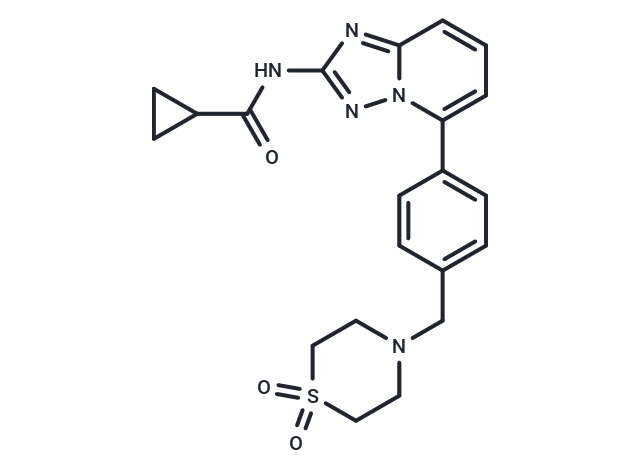Shopping Cart
- Remove All
 Your shopping cart is currently empty
Your shopping cart is currently empty

Filgotinib (GLPG0634) is a selective JAK1 inhibitor with IC50 values of 10 nM for JAK1, 28 nM for JAK2, 810 nM for JAK3, and 116 nM for TYK2.

| Pack Size | Price | Availability | Quantity |
|---|---|---|---|
| 1 mg | $33 | In Stock | |
| 5 mg | $71 | In Stock | |
| 10 mg | $112 | In Stock | |
| 25 mg | $166 | In Stock | |
| 50 mg | $263 | In Stock | |
| 100 mg | $347 | In Stock | |
| 1 mL x 10 mM (in DMSO) | $71 | In Stock |
| Description | Filgotinib (GLPG0634) is a selective JAK1 inhibitor with IC50 values of 10 nM for JAK1, 28 nM for JAK2, 810 nM for JAK3, and 116 nM for TYK2. |
| Targets&IC50 | JAK3:810 nM, TYK2:116 nM, JAK1:10 nM, JAK2:28 nM |
| In vitro | In vivo studies on mice treated with DSS demonstrate that Filgotinib (GLPG0634), through the inhibition of JAK1, exhibits potent efficacy in preclinical mouse models, which is associated with the inhibition of STAT3 phosphorylation in inflamed colonic tissues. Oral administration of Filgotinib shows moderate absolute bioavailability in rats (45%) and high bioavailability in mice (~100%). In both rat and mouse CIA models, Filgotinib (30 mg/kg/day in rats; 50 mg/kg, twice per day in mice) demonstrates a dose-dependent reduction in cartilage damage, inflammation, and bone degeneration phenomena. |
| In vivo | In cell lines, GLPG0634 inhibits the signaling of JAK1/JAK3/γc induced by IL-2/4 and the signaling of JAK1/TYK2 Type II receptor induced by IFN-αB2, with an IC50 of 150-760 nM. Compared to JAK1 kinase in the JAK/STAT signaling pathway, GLPG0634 exhibits higher selectivity for JAK2 kinase at the cellular level. Additionally, GLPG0634 inhibits the differentiation of Th1/2/17 cells. |
| Kinase Assay | Recombinant JAK1, TYK2, JAK2, and JAK3 are used to develop activity assays in 50 mM HEPES (pH 7.5), 1 mM EGTA, 10 mM MgCl2, 2 mM DTT, and 0.01% Tween 20. The amount of JAK protein is determined per aliquot, maintaining initial velocity and linearity over time. The ATP concentration is equivalent to 4× the experimental?Km?value and the substrate concentration (ULight-conjugated JAK-1(Tyr1023) peptide) corresponds to the experimentally determined?Km?value. After 90 min incubation at room temperature (RT), the amount of phosphorylated substrate is measured by addition of 2 nM europium-anti-phosphotyrosine Ab and 10 mM EDTA in Lance detection buffer. Compound IC50?values are determined by preincubating the enzyme with compound at RT for 60 min, prior to the addition of ATP. |
| Alias | GLPG0634 |
| Molecular Weight | 425.5 |
| Formula | C21H23N5O3S |
| Cas No. | 1206161-97-8 |
| Smiles | O=C(Nc1nc2cccc(-c3ccc(CN4CCS(=O)(=O)CC4)cc3)n2n1)C1CC1 |
| Relative Density. | 1.51 g/cm3 (Predicted) |
| Storage | Powder: -20°C for 3 years | In solvent: -80°C for 1 year | Shipping with blue ice. | |||||||||||||||||||||||||||||||||||
| Solubility Information | Ethanol: < 1 mg/mL (insoluble or slightly soluble) H2O: < 1 mg/mL (insoluble or slightly soluble) DMSO: 50 mg/mL (117.51 mM), Sonication is recommended. | |||||||||||||||||||||||||||||||||||
Solution Preparation Table | ||||||||||||||||||||||||||||||||||||
DMSO
| ||||||||||||||||||||||||||||||||||||

Copyright © 2015-2025 TargetMol Chemicals Inc. All Rights Reserved.